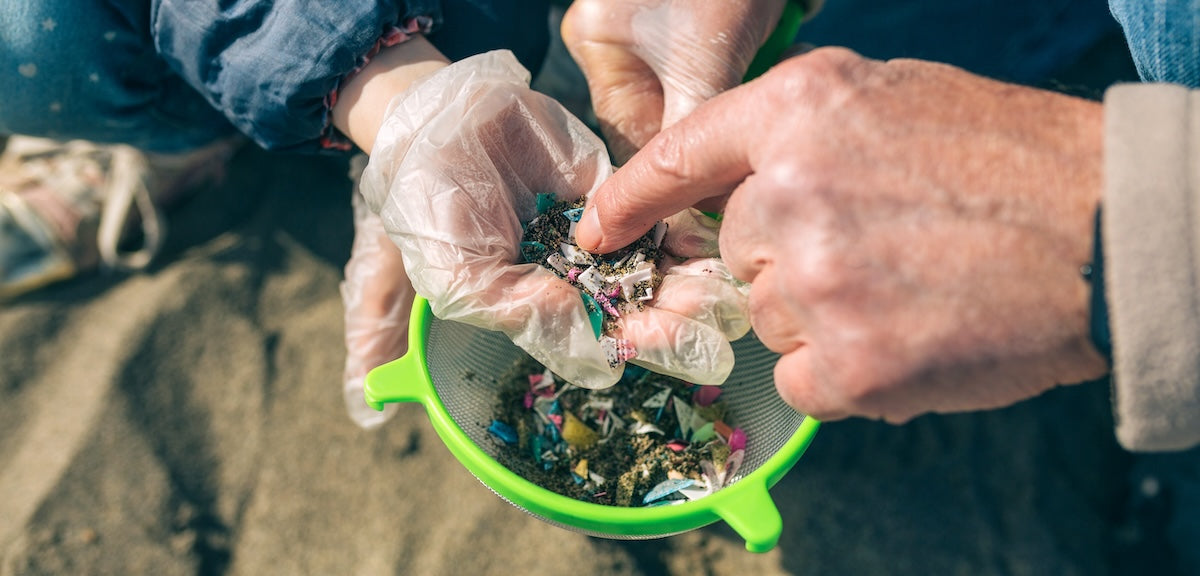
As people who care about the environment, we do our best to keep the planet clean. From daily recycling habits to regular beach clean-ups, environmentalists work tirelessly to reduce the negative impact of plastic pollution. While removing plastic waste from beaches and parks is a valuable step, it doesn’t address the root cause of the problem — microplastics.
Plastics break down into tiny particles that harm the natural balance of ecosystems and the organisms that live in them — remaining in the environment long after the original plastic product has been removed. So, to help you understand the severity of this environmental crisis, let's talk about the dangers of microplastics and how to avoid them in your daily life!

Pollution
From synthetic clothing to plastic water bottles, microplastics are shed from the plastic products commonly used every day — especially when washed with hot water, scrubbed, microwaved, or left in the sun. These tiny plastic particles can be washed down the drain, into the ocean, or littered on the ground — and once they permeate the environment, they’re nearly impossible to remove.
Bioaccumulation
These plastic particles don’t just sit in the environment. They contain and release chemicals that contaminate and pollute ecosystems. Over time, the particles build up and settle in places where they don’t belong, such as soil, sand, and bodies of water. As a result, they disrupt the ecosystems and organisms that live there. What’s more, microplastics in the ocean can attract and carry pollutants already present in the water.

Ingestion
These tiny, often colourful pieces are easily consumed by unsuspecting animals that drink contaminated water or mistake them for food. They are also commonly inhaled or ingested by humans who wear synthetic clothing, drink from plastic water bottles, or eat hot food from plastic containers. Unsurprisingly, the chemicals in these microplastics are toxic to both animals and humans.
Movement
One of the major sources of microplastics in the human body is seafood. Once ingested by smaller animals such as fish, microplastics can move up the food chain. Any predators — including humans — who consume fish that have ingested microplastics are exposed to the harmful effects as well.

Damage
Microplastics can cause severe health problems for many animals, damaging their digestive systems, contributing to malnutrition, making them more vulnerable to illnesses, and even causing death. For humans, exposure to chemicals leaching from microplastics may lead to endocrine disruption, weight gain, impaired reproductive health, and even cancer. These harmful effects on organisms inevitably upset the natural balance of our ecosystems.
Removal
Removing microplastics from the environment is an almost impossible task. They take hundreds, even thousands, of years to break down, and during this process, they can release greenhouse gases that contribute to climate change. The best way to reduce these negative effects is to prevent microplastics from entering the environment in the first place.

Solutions
Wondering how to avoid microplastics in your daily life? While going completely plastic-free can be challenging, reducing your plastic use can have a huge positive impact! We recommend choosing natural fibre clothing over synthetics, cutting out all single-use plastics, and limiting reusable plastic items as much as possible. To get started, swap any reusable food or drink containers with plastic parts for truly microplastic-free alternatives!
At Pura Stainless, our mission is to be part of the solution to the environmental and health crises caused by microplastics. That’s why we created the first and only line of 100% microplastic-free water bottles, baby bottles, and lunch containers for people of all ages — providing families like yours with affordable, safe, durable, and truly sustainable options, so you never have to buy single-use or reusable plastic bottles or containers again. Visit our website to learn more about the dangers of plastics, how to avoid microplastics in your daily life, and to explore our eco-friendly products!



